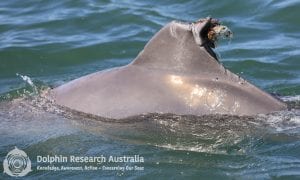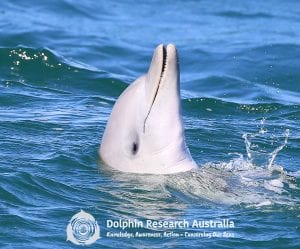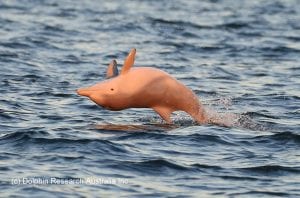Dolphins of Moreton Bay, Queensland
What dolphin species live in Moreton Bay?
Two species of dolphins, the Australian humpback dolphin (Sousa sahulensis) and Indo-Pacific bottlenose dolphin (Tursiops aduncus) inhabit Moreton Bay all year round. These species are the focus of our Moreton Bay Dolphin Research Project, particularly the humpback dolphin which has been classified as Vulnerable and a species of high priority. Assessing the trends in abundance and ecology of dolphin populations requires long-term research projects to determine the health and risks associated with threatening processes.

Fishing line entanglement on a young Indo-Pacific bottlenose dolphin in Moreton Bay.
Why are Moreton Bay’s dolphins important?
Bordered by the bustling cities of South East Queensland and the beautiful Moreton, North Stradbroke and Bay Islands, Moreton Bay (Quandamooka) is a special place. Yet, there are many pressures on the natural environment and wildlife as a result of human activities. Located adjacent to one of Australia’s major cities with a rapidly increasing population, and a major Port, has led to rapid changes and increased pressures to the habitats and wildlife of the Bay in recent decades. This has seen increased pollution, sedimentation, habitat degradation, coastal development, boating, fishing and tourism activities in the Bay which in turn, presents a cocktail of threats to the local dolphin populations.
These dolphins are not only important to sustain a functioning ecosystem, but also economically and culturally. The Quandamooka People have shared a strong connection with the dolphins (Buangan) for generations. Yet, the future of dolphins in Moreton Bay is uncertain in the face of cumulative pressures posed by human activities which raise concerns about the health, well-being and status of these populations. Our research is critical to ensuring the protection and conservation of the dolphin populations by providing an understanding of and monitoring their health and status.


